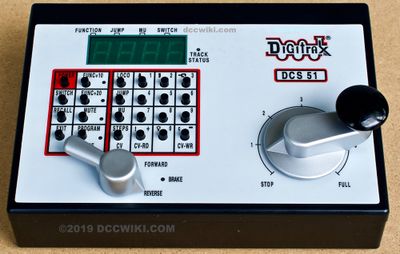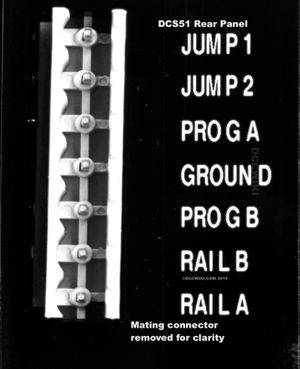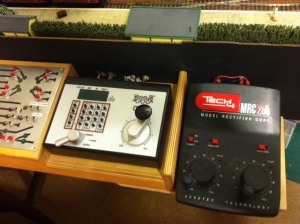Jump Port
The Digitrax Zephyr command station is equipped with two JumpTM Ports that allow up to two traditional analog throttles to be used as additional DCC throttles. This allows the Zephyr to control up to three locomotives simultaneously with three independent throttles.
Jump Ports
Jump Ports are a feature of the Digitrax Zephyr series of DCC starter sets.
How the Jump Port Works
The command station has three additional input connections: JUMP 1, JUMP 2 and GROUND. The variable output of each analog throttle is connected between ground and one Jump port. The command station measures the voltage and polarity to determine the desired speed and direction (forward or reverse). The command station draws only a very small current from the analog throttle (about 10mA).
Operation
To set up a throttle it must be selected on the Zephyr command station by pressing the JUMP button, this cycles around the local throttle, Jump 1 and Jump 2. Setting the locomotive address or any of the function buttons apply only to that throttle. Once set up, all three throttles are always "live" meaning that each one is always controlling its locomotive's direction and speed regardless of which throttle is selected by the JUMP button. The emergency stop feature (the POWER button) will always stop all of the locomotives regardless of which throttle is controlling them.
Installation
Each analog throttle should be wired directly to one of the Zephyr's jump inputs and to the ground input. If two throttles are used, they share the ground input.
CAUTION: Zephyr jump ports require the analog throttles to be able to work in common return mode. It is expected that all recent and currently available dual output analog throttles are able to work in this mode but for older models consult the manufacturer's instructions.
DIY Throttle
There are several complications when attempting to build DIY jump throttles; it is not as simple as wiring up a couple of potentiometers and reversing switches to a 12V power supply.
- The first problem: The Zephyr expects the jump throttles to work using a common return scheme where both input throttles share the same ground connection. This means that if the two throttles are operating in opposite directions, then the expected input voltages need to be +12V, -12V and ground.
- CAUTION Failure to design the jump throttles correctly could result in serious damage when using a single power supply as it will create a direct short circuit when one reversing switch is thrown.
- The Zephyr is expecting to be driven by high current analog throttles; therefore, it has a relatively low input resistance (about 1KΩ). If a simple DIY throttle is built with a typical 10KΩ potentiometer, the throttle response will be very non-linear. Some type of transistor amplification is required to maintain a linear voltage response.
- The Zephyr expects about 12V to indicate full throttle so if a DIY throttle is built with a 9V battery then it will only be able to achieve about 3/4 throttle.


